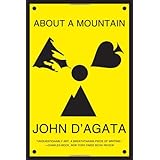
Average Reviews:

(More customer reviews)The critical reviews I have read of D'Agata's About a Mountain have been substantially the same: this is a book that shows incredible breadth of perception and seemingly bottomless insight on human nature, all in a really well-written essay, BUT...where are we going in the end? NYT was also critical of some of the artistic liberties that D'Agata took with the facts. I share the former concerns and was less troubled by the latter.
In fact, for me the biggest criticism is that the book was almost too virtoustic on D'Agata's part. Early on, I felt that I was reading a transformative piece of nonfiction literature. D'Agata sets out on a very promising path, writing a piece of really compelling nature/environmental literature that is only enhanced by his ability to make the point without descending into pedanticism, as so much of today's advocacy lit does.
Unfortunately, the tenuous threads that connect D'Agata's observations and meanderings to the Yucca Mountain story in the beginning only fray as the narrative progresses. He leaves behind the bar room and the environmental advocates that he joins to watch the CSPAN debate over the mountatin's fate, and the tangents and associations that his mind makes are never quite as persuasive. Of course, a piece of literature need not be convincing or argumentative at all to be enjoyable and here is to what Phillip Nobile called "intellectual skywriting." Still, the beauty of a piece achieves full flower when it delivers both on its intended persuasion and artistry.
Without a doubt, there are moments where the reader is awed by D'Agata's skill. For example, describing a rag-tag Potemkin parade commemorating Vegas' founding, D'Agata recounts "An Elvis showed up briefly. Turned out he was lost." That is the kind of simple, declarative sentence that shows both the brilliance and the restraint that is necessary to trust yourself and your reader to understand and appreciate context and subtlety.
Unfortunately, there are fewer of these moments as the book progresses. And, when they come, they are too much like the moments when a basketball player passes up the open man to perform his own high-flying dunk. "He pulled the left sock on his left foot up," D'Agata later recounts, in one of the more heavily constructed retellings of an interview. Is this to imply that he might have had a right sock on his left foot? Or, is it merely redundant and gilded and trite?
In this way, the artist was too often allowed to fully indulge himself, and I wish someone had reined him in. There are other examples and they grated on me more as the book wore on (including D'Agata's tendency to string sentences along by taxing "and" to within an inch of its life, as if to prove that it is possible and acceptable to write scores of words without punctuation as long the sentence can still diagram properly).
Sometimes, an artist's best work is better constrained. Four stars for the author, two stars for the editor, three stars for the book.
Click Here to see more reviews about: About a Mountain

0 comments:
Post a Comment